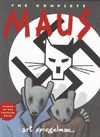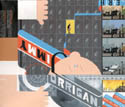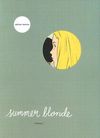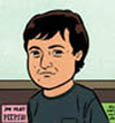Chris Oliveros
By Andrew Duncan
|
|
Since the early 1990s, Montreal-based Drawn and Quarterly has maintained a reputation as one of North America's premier publishers of literary comic books and graphic novels.
Besides their stunning annual anthology -- which features contributions from an international roster of journalists and cartoonists -- Drawn and Quarterly's series of widely acclaimed graphic novels include Seth's It's a Good Life if You Don't Weaken, Jason Lutes' Berlin, Debbie Drechsler's Summer of Love, and Michel Rabagliati's Paul Has a Summer Job.
Recently, after narrowly averting financial disaster due to the bankruptcy of their distributor, Drawn and Quarterly signed with Chronicle Books, and published a free pamphlet that offered advice to booksellers on how to sell graphic novels: The Drawn and Quarterly Manifesto.
Taking some time off from his busy summer schedule, Drawn and Quarterly mastermind Chris Oliveros sat down with us to discuss graphic novels, the Manifesto, and what his company has coming up in the latter half of 2003.
How did Drawn and Quarterly get started?
 It began in 1990 as a comics anthology called Drawn and Quarterly, which we published four times a year. Since then, the anthology has evolved into an annual coffee-table book that's much larger and contains much more material.
It began in 1990 as a comics anthology called Drawn and Quarterly, which we published four times a year. Since then, the anthology has evolved into an annual coffee-table book that's much larger and contains much more material.
When I was first coming into contact with creators for the magazine, I ended up meeting a lot of cartoonists -- Seth, Chester Brown, Julie Doucet -- who had a lot of their own work. One thing led to another, and we just ended up publishing other comic books. In the first two or three years we actually didn't publish bound books. Everything was in periodical format.
Why comic books?
The Drawn and Quarterly magazine was inspired to a large degree by Art Spiegelman's anthology Raw. I was about 15, and I remember seeing the first issue of Raw when it came out -- this is about 21 years ago or something like that -- and it was like a revelation to me. Before then I had only known what most people consider to be standard comics, and then all of a sudden I saw this magazine that showed you could really do anything with comics both graphically and story-wise. It really sort of turned the whole definition of comics on its head. From then on I really had a very keen interest in somehow being involved in the medium myself.
What is the Drawn and Quarterly Manifesto?
 Basically, the Manifesto is an informative step-by-step guide by booksellers for booksellers that explains how to sell graphic novels.
Basically, the Manifesto is an informative step-by-step guide by booksellers for booksellers that explains how to sell graphic novels.
When we signed up with our distributor Chronicle Books a few months ago, one of the initial problems we were facing was that most bookstores didn't or don't have a proper graphic novel section. It was great that Chronicle could get the books out there, but we were concerned a lot of bookstores wouldn't really know how to handle graphic novels. So, we commissioned a handful of booksellers who have had success selling graphic novels to write testimonials on how they've done it.
What do booksellers and their customers need to know about graphic novels?
Well, I think the most important thing is they both need to know that graphic novels are not a genre. They're part of an extremely varied medium. There are comics for kids and adolescents, but there are also comics for adults that cover just about everything general fiction covers.
Many of the bookstores that actually do have a graphic novel section are selling Maus next to X-Men, which is just wrong because they're two very different books for two very different audiences. Those books aren't reaching the number of people they could be reaching. People who would be interested in a graphic novel about Bosnia or Palestine or whatever are not going to want to sift through the Star Wars books, and vice versa. It's kind of like having cookbooks and putting them in the gardening section.
How would a bookseller go about building a good graphic novel section? And where should readers start looking?
 Ideally, bookstores would have a graphic novel section that separates the books into sub-sections. This is a lot easier now because BISAC [Book Industry Standards Advisory Committee] -- they set all the categories of books -- recently agreed to officially recognize graphic novels by giving them their own category in bookstores, plus various sub-sections: graphic novel/literary, graphic novel/manga, etc.
Ideally, bookstores would have a graphic novel section that separates the books into sub-sections. This is a lot easier now because BISAC [Book Industry Standards Advisory Committee] -- they set all the categories of books -- recently agreed to officially recognize graphic novels by giving them their own category in bookstores, plus various sub-sections: graphic novel/literary, graphic novel/manga, etc.
If that's too much for a bookstore to do -- asking a retailer to rearrange their floor space is a tall order -- then the second-best thing would be to take an existing section like "Popular Culture," and mix in some titles there.
What books do you recommend for readers who might be interested in graphic novels, but don't know where to start?
Art Spiegelman's Maus is probably the graphic novel that's received the most accolades in the past 10 or 15 years. And then of course there would be Jimmy Corrigan by Chris Ware, which came out a couple years ago and won the Guardian Literary Prize.


A Drawn and Quarterly book that's one of my favorites is called I Never Liked You by Chester Brown. Another one of our recent releases is Summer Blonde by Adrian Tomine, which is a book of short stories.


What does Drawn and Quarterly have upcoming in 2003?
There's quite a lot, actually. We're doing new art books with Robert Crumb and Chris Ware. A little later in the year we'll be doing a hardcover of Chester Brown's Louis Riel. And we're also doing a new book with Joe Sacco called The Fixer, which continues his series on Bosnia.

